Shuai Ma
AIR: Post-training Data Selection for Reasoning via Attention Head Influence
Dec 15, 2025Abstract:LLMs achieve remarkable multi-step reasoning capabilities, yet effectively transferring these skills via post-training distillation remains challenging. Existing data selection methods, ranging from manual curation to heuristics based on length, entropy, or overall loss, fail to capture the causal importance of individual reasoning steps, limiting distillation efficiency. To address this, we propose Attention Influence for Reasoning (AIR), a principled, unsupervised and training-free framework that leverages mechanistic insights of the retrieval head to select high-value post-training data. AIR first identifies reasoning-critical attention heads of an off-the-shelf model, then constructs a weakened reference model with disabled head influence, and finally quantifies the resulting loss divergence as the Attention Influence Score. This score enables fine-grained assessment at both the step and sample levels, supporting step-level weighted fine-tuning and global sample selection. Experiments across multiple reasoning benchmarks show that AIR consistently improves reasoning accuracy, surpassing heuristic baselines and effectively isolating the most critical steps and samples. Our work establishes a mechanism-driven, data-efficient approach for reasoning distillation in LLMs.
SITP: A High-Reliability Semantic Information Transport Protocol Without Retransmission for Semantic Communication
Dec 10, 2025Abstract:With the evolution of 6G networks, modern communication systems are facing unprecedented demands for high reliability and low latency. However, conventional transport protocols are designed for bit-level reliability, failing to meet the semantic robustness requirements. To address this limitation, this paper proposes a novel Semantic Information Transport Protocol (SITP), which achieves TCP-level reliability and UDP level latency by verifying only packet headers while retaining potentially corrupted payloads for semantic decoding. Building upon SITP, a cross-layer analytical model is established to quantify packet-loss probability across the physical, data-link, network, transport, and application layers. The model provides a unified probabilistic formulation linking signal noise rate (SNR) and packet-loss rate, offering theoretical foundation into end-to-end semantic transmission. Furthermore, a cross-image feature interleaving mechanism is developed to mitigate consecutive burst losses by redistributing semantic features across multiple correlated images, thereby enhancing robustness in burst-fade channels. Extensive experiments show that SITP offers lower latency than TCP with comparable reliability at low SNRs, while matching UDP-level latency and delivering superior reconstruction quality. In addition, the proposed cross-image semantic interleaving mechanism further demonstrates its effectiveness in mitigating degradation caused by bursty packet losses.
NOC4SC: A Bandwidth-Efficient Multi-User Semantic Communication Framework for Interference-Resilient Transmission
Dec 10, 2025Abstract:With the explosive growth of connected devices and emerging applications, current wireless networks are encountering unprecedented demands for massive user access, where the inter-user interference has become a critical challenge to maintaining high quality of service (QoS) in multi-user communication systems. To tackle this issue, we propose a bandwidth-efficient semantic communication paradigm termed Non-Orthogonal Codewords for Semantic Communication (NOC4SC), which enables simultaneous same-frequency transmission without spectrum spreading. By leveraging the Swin Transformer, the proposed NOC4SC framework enables each user to independently extract semantic features through a unified encoder-decoder architecture with shared network parameters across all users, which ensures that the user's data remains protected from unauthorized decoding. Furthermore, we introduce an adaptive NOC and SNR Modulation (NSM) block, which employs deep learning to dynamically regulate SNR and generate approximately orthogonal semantic features within distinct feature subspaces, thereby effectively mitigating inter-user interference. Extensive experiments demonstrate the proposed NOC4SC achieves comparable performance to the DeepJSCC-PNOMA and outperforms other multi-user SemCom baseline methods.
A Style is Worth One Code: Unlocking Code-to-Style Image Generation with Discrete Style Space
Nov 19, 2025Abstract:Innovative visual stylization is a cornerstone of artistic creation, yet generating novel and consistent visual styles remains a significant challenge. Existing generative approaches typically rely on lengthy textual prompts, reference images, or parameter-efficient fine-tuning to guide style-aware image generation, but often struggle with style consistency, limited creativity, and complex style representations. In this paper, we affirm that a style is worth one numerical code by introducing the novel task, code-to-style image generation, which produces images with novel, consistent visual styles conditioned solely on a numerical style code. To date, this field has only been primarily explored by the industry (e.g., Midjourney), with no open-source research from the academic community. To fill this gap, we propose CoTyle, the first open-source method for this task. Specifically, we first train a discrete style codebook from a collection of images to extract style embeddings. These embeddings serve as conditions for a text-to-image diffusion model (T2I-DM) to generate stylistic images. Subsequently, we train an autoregressive style generator on the discrete style embeddings to model their distribution, allowing the synthesis of novel style embeddings. During inference, a numerical style code is mapped to a unique style embedding by the style generator, and this embedding guides the T2I-DM to generate images in the corresponding style. Unlike existing methods, our method offers unparalleled simplicity and diversity, unlocking a vast space of reproducible styles from minimal input. Extensive experiments validate that CoTyle effectively turns a numerical code into a style controller, demonstrating a style is worth one code.
Modeling and Performance Analysis for Semantic Communications Based on Empirical Results
Apr 29, 2025
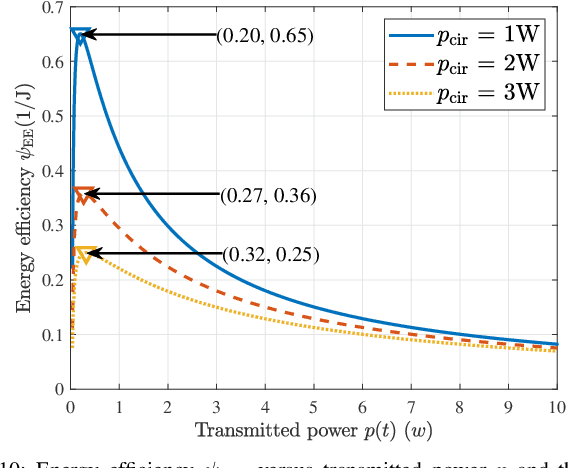

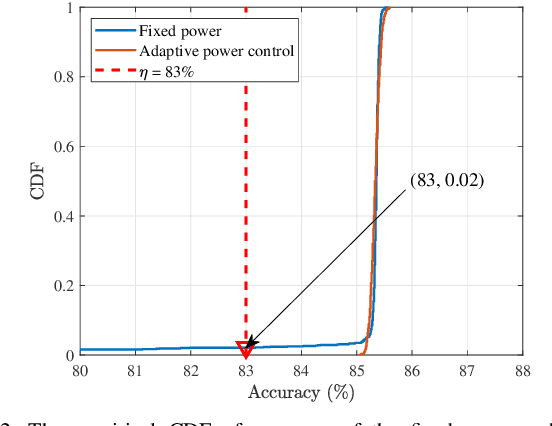
Abstract:Due to the black-box characteristics of deep learning based semantic encoders and decoders, finding a tractable method for the performance analysis of semantic communications is a challenging problem. In this paper, we propose an Alpha-Beta-Gamma (ABG) formula to model the relationship between the end-to-end measurement and SNR, which can be applied for both image reconstruction tasks and inference tasks. Specifically, for image reconstruction tasks, the proposed ABG formula can well fit the commonly used DL networks, such as SCUNet, and Vision Transformer, for semantic encoding with the multi scale-structural similarity index measure (MS-SSIM) measurement. Furthermore, we find that the upper bound of the MS-SSIM depends on the number of quantized output bits of semantic encoders, and we also propose a closed-form expression to fit the relationship between the MS-SSIM and quantized output bits. To the best of our knowledge, this is the first theoretical expression between end-to-end performance metrics and SNR for semantic communications. Based on the proposed ABG formula, we investigate an adaptive power control scheme for semantic communications over random fading channels, which can effectively guarantee quality of service (QoS) for semantic communications, and then design the optimal power allocation scheme to maximize the energy efficiency of the semantic communication system. Furthermore, by exploiting the bisection algorithm, we develop the power allocation scheme to maximize the minimum QoS of multiple users for OFDMA downlink semantic communication Extensive simulations verify the effectiveness and superiority of the proposed ABG formula and power allocation schemes.
Task-Oriented Semantic Communication with Importance-Aware Rate Control
Apr 29, 2025



Abstract:Semantic communication is recognized for its high compression efficiency and robust resistance to noise. However, utilizing a fixed transmission rate in environments with dynamic signal-to-noise ratios (SNR) often results in inefficient use of communication resources. To address this challenge, this letter proposes an importance-aware rate control semantic communication (IRCSC) scheme, which dynamically adjusts transmission rates in response to both channel conditions and semantic importance. The scheme employs a contribution-based importance analyzer to rank semantic importance. Additionaly, a novel metric, the semantic transmission integrity index (STII), is proposed to quantify the amount of correctly transmitted information and to correlate it with inference performance. Simulations indicate that, with low computational complexity, IRCSC guarantees a controllable trade-off between performance and rate, delivering higher compression efficiency and improved task performance in high-SNR scenarios.
Leveraging Labelled Data Knowledge: A Cooperative Rectification Learning Network for Semi-supervised 3D Medical Image Segmentation
Feb 17, 2025Abstract:Semi-supervised 3D medical image segmentation aims to achieve accurate segmentation using few labelled data and numerous unlabelled data. The main challenge in the design of semi-supervised learning methods consists in the effective use of the unlabelled data for training. A promising solution consists of ensuring consistent predictions across different views of the data, where the efficacy of this strategy depends on the accuracy of the pseudo-labels generated by the model for this consistency learning strategy. In this paper, we introduce a new methodology to produce high-quality pseudo-labels for a consistency learning strategy to address semi-supervised 3D medical image segmentation. The methodology has three important contributions. The first contribution is the Cooperative Rectification Learning Network (CRLN) that learns multiple prototypes per class to be used as external knowledge priors to adaptively rectify pseudo-labels at the voxel level. The second contribution consists of the Dynamic Interaction Module (DIM) to facilitate pairwise and cross-class interactions between prototypes and multi-resolution image features, enabling the production of accurate voxel-level clues for pseudo-label rectification. The third contribution is the Cooperative Positive Supervision (CPS), which optimises uncertain representations to align with unassertive representations of their class distributions, improving the model's accuracy in classifying uncertain regions. Extensive experiments on three public 3D medical segmentation datasets demonstrate the effectiveness and superiority of our semi-supervised learning method.
Separate Motion from Appearance: Customizing Motion via Customizing Text-to-Video Diffusion Models
Jan 28, 2025Abstract:Motion customization aims to adapt the diffusion model (DM) to generate videos with the motion specified by a set of video clips with the same motion concept. To realize this goal, the adaptation of DM should be possible to model the specified motion concept, without compromising the ability to generate diverse appearances. Thus, the key to solving this problem lies in how to separate the motion concept from the appearance in the adaptation process of DM. Typical previous works explore different ways to represent and insert a motion concept into large-scale pretrained text-to-video diffusion models, e.g., learning a motion LoRA, using latent noise residuals, etc. While those methods can encode the motion concept, they also inevitably encode the appearance in the reference videos, resulting in weakened appearance generation capability. In this paper, we follow the typical way to learn a motion LoRA to encode the motion concept, but propose two novel strategies to enhance motion-appearance separation, including temporal attention purification (TAP) and appearance highway (AH). Specifically, we assume that in the temporal attention module, the pretrained Value embeddings are sufficient to serve as basic components needed by producing a new motion. Thus, in TAP, we choose only to reshape the temporal attention with motion LoRAs so that Value embeddings can be reorganized to produce a new motion. Further, in AH, we alter the starting point of each skip connection in U-Net from the output of each temporal attention module to the output of each spatial attention module. Extensive experiments demonstrate that compared to previous works, our method can generate videos with appearance more aligned with the text descriptions and motion more consistent with the reference videos.
TAPFed: Threshold Secure Aggregation for Privacy-Preserving Federated Learning
Jan 09, 2025



Abstract:Federated learning is a computing paradigm that enhances privacy by enabling multiple parties to collaboratively train a machine learning model without revealing personal data. However, current research indicates that traditional federated learning platforms are unable to ensure privacy due to privacy leaks caused by the interchange of gradients. To achieve privacy-preserving federated learning, integrating secure aggregation mechanisms is essential. Unfortunately, existing solutions are vulnerable to recently demonstrated inference attacks such as the disaggregation attack. This paper proposes TAPFed, an approach for achieving privacy-preserving federated learning in the context of multiple decentralized aggregators with malicious actors. TAPFed uses a proposed threshold functional encryption scheme and allows for a certain number of malicious aggregators while maintaining security and privacy. We provide formal security and privacy analyses of TAPFed and compare it to various baselines through experimental evaluation. Our results show that TAPFed offers equivalent performance in terms of model quality compared to state-of-the-art approaches while reducing transmission overhead by 29%-45% across different model training scenarios. Most importantly, TAPFed can defend against recently demonstrated inference attacks caused by curious aggregators, which the majority of existing approaches are susceptible to.
* The paper has been published in IEEE TDSC
LLMs are Also Effective Embedding Models: An In-depth Overview
Dec 17, 2024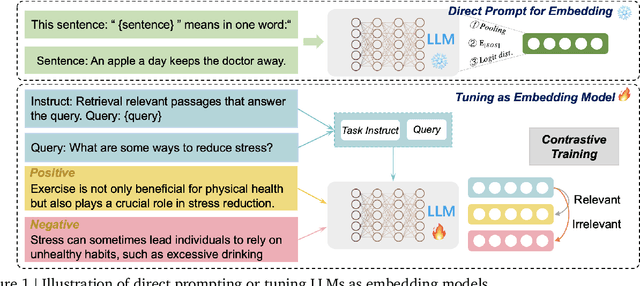
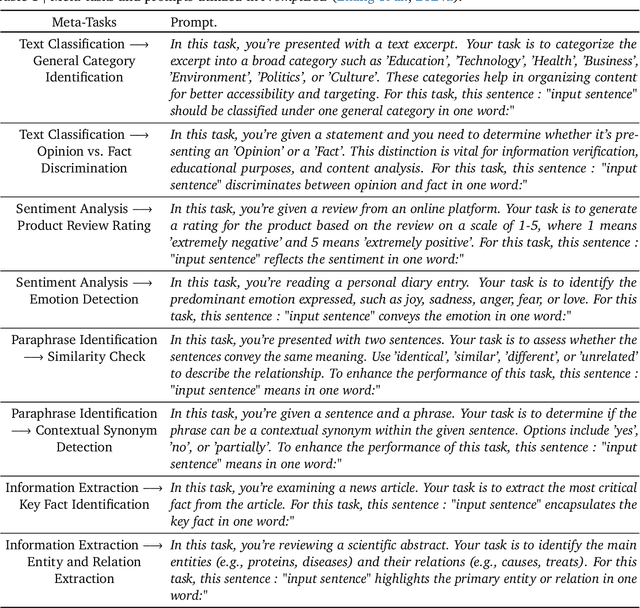
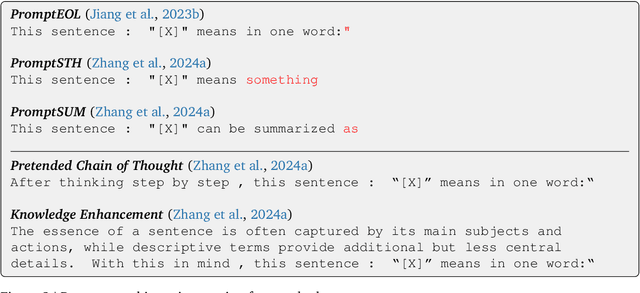

Abstract:Large language models (LLMs) have revolutionized natural language processing by achieving state-of-the-art performance across various tasks. Recently, their effectiveness as embedding models has gained attention, marking a paradigm shift from traditional encoder-only models like ELMo and BERT to decoder-only, large-scale LLMs such as GPT, LLaMA, and Mistral. This survey provides an in-depth overview of this transition, beginning with foundational techniques before the LLM era, followed by LLM-based embedding models through two main strategies to derive embeddings from LLMs. 1) Direct prompting: We mainly discuss the prompt designs and the underlying rationale for deriving competitive embeddings. 2) Data-centric tuning: We cover extensive aspects that affect tuning an embedding model, including model architecture, training objectives, data constructions, etc. Upon the above, we also cover advanced methods, such as handling longer texts, and multilingual and cross-modal data. Furthermore, we discuss factors affecting choices of embedding models, such as performance/efficiency comparisons, dense vs sparse embeddings, pooling strategies, and scaling law. Lastly, the survey highlights the limitations and challenges in adapting LLMs for embeddings, including cross-task embedding quality, trade-offs between efficiency and accuracy, low-resource, long-context, data bias, robustness, etc. This survey serves as a valuable resource for researchers and practitioners by synthesizing current advancements, highlighting key challenges, and offering a comprehensive framework for future work aimed at enhancing the effectiveness and efficiency of LLMs as embedding models.
 Add to Chrome
Add to Chrome Add to Firefox
Add to Firefox Add to Edge
Add to Edge